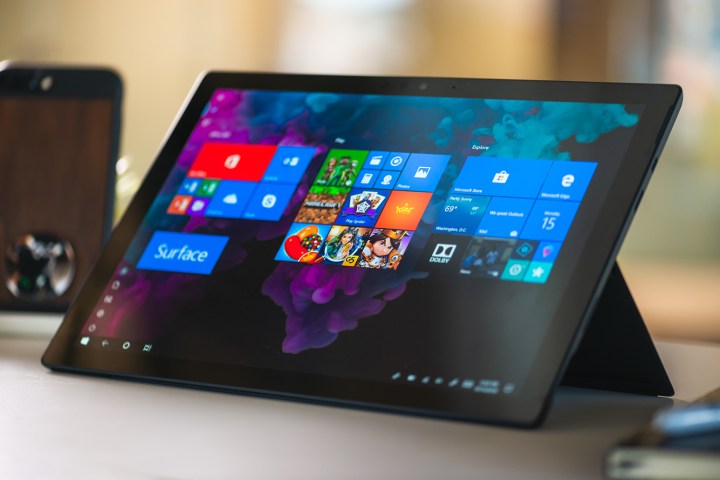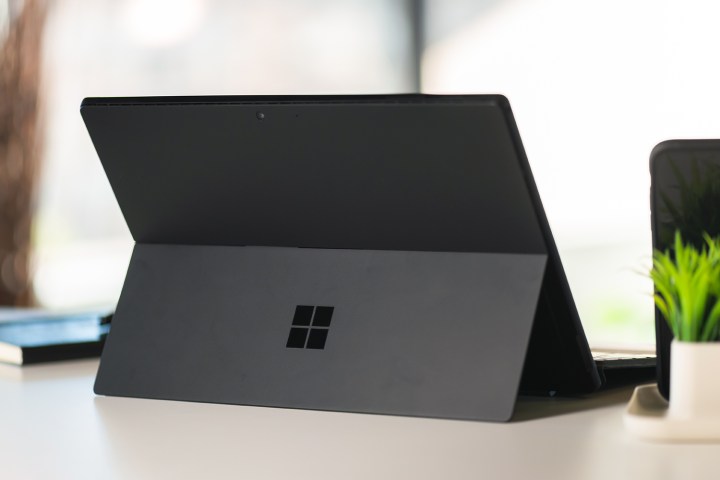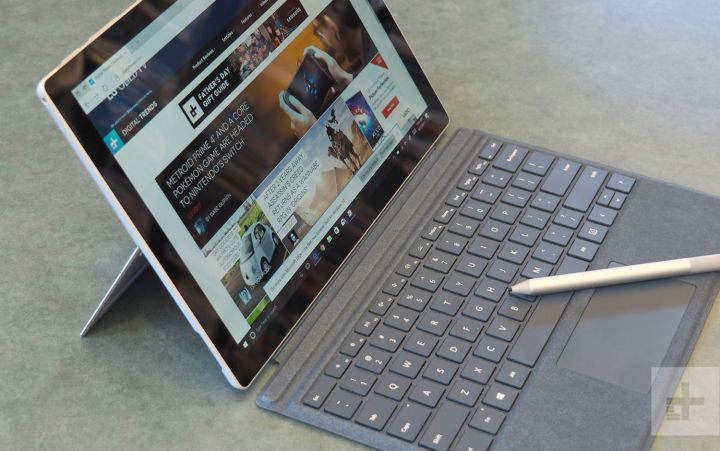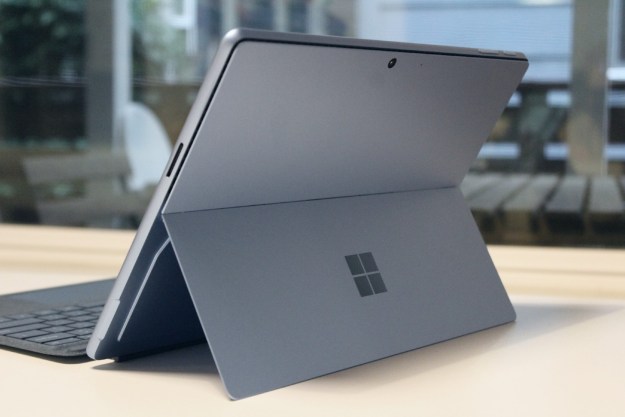Microsoft’s Surface Pro family still remains our favorite 2-in-1 PCs, so when a new version arrives on our digital doorstep, we get highly excited. But how much better — if at all — is the next-generation hardware?

In this article, we look back at the Surface Pro 6 versus Surface Pro 5 comparison, as we pitted them against each other on all of the most important factors of a modern detachable PC. For a more current battle, we compare the Pro 6 and the latest Pro 7 model in a separate article.
Note that Microsoft originally branded the Pro 5 as “Surface Pro” when it arrived in 2017. The naming confused buyers, so Microsoft now labels it as “Surface Pro (5th Gen).” Here we describe it as “Surface Pro 5” or “Pro 5” to make identification (and typing) easier.
Design

Launched in 2017, the Surface Pro 5 only saw minor physical alterations over its predecessor. The Surface Pro 6, released in 2018, is much the same.
The Pro 6 features a matte black material coating that arguably gives it a more professional look. The finish itself is supposedly a little thicker than previous models, leading to some weight and size shaving on the internal frame to maintain the exact same Pro 5 dimensions. Its overall weight is a few grams lighter, though it’s not noticeable.
The layout of the two devices is much the same, with bezels that are on the thicker side — a hallmark of devices earmarked for regular tablet use. However, they are a little more rounded at the corners on the Pro 6 than the Pro 5.
Even port selection — one of the Pro 5’s weak points — hasn’t changed. Both 2-in-1s provide a single USB-A port, a microSDXC card reader, a mini-DisplayPort, a headphone jack, and a Surface Connect port.
Unfortunately, neither device provides a USB-C or Thunderbolt 3 connector. While that wasn’t so much of a problem with the Pro 5, the lack of it on the Pro 6 is of greater concern as few modern 2-in-1s or laptops come without one.
Performance

The most important generational refresh with each Surface Pro model is the internal hardware.
The base Pro 5 model has a seventh-generation Intel Core m3-7Y30 dual-core CPU, 4GB of RAM, and a 128GB SSD. There are also a variety of set configurations offering up to 16GB of memory, better onboard graphics, and lots of extra storage. Configurations include the more powerful dual-core i5-7300U and i7-7660U CPUs, the latter of which serves as the Pro 5’s top offering.
At the time, the most expensive Pro 5 configuration set you back $2,700. You can still find the Surface Pro 5 in new and refurbished condition on third-party outlets, like Amazon.
The newer Surface Pro 6 not only has far more powerful hardware but at a far more competitive price. The $900 base model includes 8GB of RAM, 128GB of storage, and an eighth-generation quad-core Core i5-8250U CPU. That’s not only more powerful than the dual-core i5 chip in the Surface Pro 5 but far more capable than the $900 Pro 5’s dual-core m3 CPU.
But that’s just the beginning. Pro 6 configurations also include the pricier quad-core i5-8350U chip, or for $1,500 you can get a quad-core i7-8650U CPU with 256GB of storage. The top configuration comes with 16GB of RAM and 1TB of storage for $2,300. You can still purchase the Surface Pro 6 through Microsoft.
While the Pro 6 model is faster in most respects, it is slower in one area. You can purchase top-tier Pro 5 configurations with processors that have Intel Iris Plus 640 graphics. That’s a much more powerful graphics core than the UHD 620 found in the Pro 6’s i7-8650U CPU. While the newer 2-in-1 is a much more powerful machine when it comes to general computing, gaming and 3D rendering may be slightly better on the last-generation hardware.
Finally, there was no change in display technology between the two generations. Both the Surface Pro 5 and Pro 6 sport the same 2,736 x 1,824 resolution PixelSense display.
Portability

Physical changes to the Surface Pro 6 are minimal despite housing new hardware, so there isn’t much difference in the physical portability of the two devices.
The Surface Pro 5 and Pro 6 both measure 11.5 x 7.9 x 0.33 inches, so the new version is no more compact and should fit in all the same carry cases and sleeves.
Weight is also close to identical, as the Pro 6 weighs 1.71 pounds with the Core i5 CPU and 1.75 pounds with the Core i7. The Surface Pro 5 weighs 1.73 pounds with the Core i7 and 1.7 pounds with the Core i5.
On the battery front, the Pro 6 is simply better. In tests, the Surface Pro 5 had 5.5 hours of battery life when web browsing, and 10 hours in a video playback loop.
With the Surface Pro 6, we saw 9.5 hours when browsing the web and more than 14 hours in video playback. That is a big jump in battery life, and something that is definitely a highlight of the Surface Pro 6.
However, we should note that both models have experienced battery problems in the past due to firmware updates, so battery life for both detachable PCs can vary.
Neither device even approaches the battery life of the market-leading Surface Book 2, however.
The Surface Pro 6’s small tweaks are worth the upgrade

The Surface Pro 6 is undoubtedly an improvement over the Surface Pro 5. But we have to admit that it retains some of the same old problems.
The Surface Pro 6 comes with some impressive upgrades from the Surface Pro 5. User’s will be happy with the quad-core processors and the long battery life, which is the most significant difference between the two machines. You’ll also be able to get the Surface Pro 6 in a black finish, which will appeal to many looking for a sleek looking laptop.
The Surface Pro 6 is not the perfect laptop. You won’t get enhanced screen resolution over the Surface Pro 5. The display screen has oddly large bezels, taking up valuable space.
Microsoft left out USB-C and other modern ports on the Surface Pro 6, proving to be an inconvenience for many. The company also didn’t use “Whiskey Lake” processors, which would have boosted performance.
However, the $900 starting price makes the Surface Pro 6 the right choice. It will last longer than the Surface Pro 5. It is faster, has improved multitasking performance, holds a more extended battery charge, and offers more hardware for your money.
If you can afford it, the minor functionality and design tweaks to the functionality and design are worth upgrading.
Editors' Recommendations
- Best Surface Laptop and Surface Pro deals: From $523
- 10 best desktop computers of 2024: tested and reviewed
- The 10 best monitors for 2024: tested and reviewed
- The most common Microsoft Teams problems and how to fix them
- Dell XPS vs. Dell Latitude: here’s how to decide



